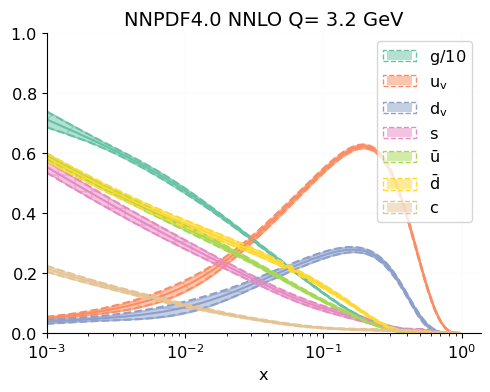Welcome to the NNPDF 4.0 gallery
We present some extended comparisons of the NNPDF 4.0 Parton Distribution Functions in order to complement the results presented in the paper, as well as to demonstrate the analysis capabilities of the public code.

Show validphys runcard
pdf: NNPDF40_nnlo_as_01180
basis: pdg
Q: 3.2
xmin: 1e-3
ymin: 0
ymax: 1
actions_:
- plot_flavoursFit comparisons
The vp-comparefits tool produces a comprehensive report comparing two NNPDF fits. We have used it to compare the default 4.0 determination with several other variations.
NNPDF 4.0 vs NNPDF 3.1
The report shows the differences between the state of the art NNPDF 4.0 determination and the previous NNPDF 3.1 results, both in terms of data and code differences. The former methodology is reproducible with the public code, allowing for automated and precise comparisons which aid the speed and quality of our research.
The report shows that the new gradient descent based methodology attains a better χ² per data point despite the much larger NNPDF 4.0 dataset in the new determination while simultaneously yielding smoother PDFs and much reduced PDF uncertainties.
Fitted vs perturbative charm
The report showcases the result of determining the charm PDF along the other light flavours. If charms is pertubatvely generated only a much different behaviour at the level of PDFs is observed while the fit quality with perturbative charm decreases across the board, particularly in the datasets more sensitive to flavour decomposition.
NLO vs NNLO
The report shows the comparison between NLO and NNLO PDF sets. In particularly it evidences that NNLO predictions and evolution help improve overall compatibility across processes.
PDF comparisons
The validphys analysis code contains a number of PDF plotting tools. We demonstrate their use here, by producing detailed benchmarks of the compressed PDF sets.
Hessian PDFs
The report shows the comparison between the 1000 NNPDF 4.0 replica set and reduced Hessian sets with 30, 50 and 100 eigenvectors. It displays absolute and ratio plots of the PDFs at initial scale, luminosities and luminosity observable as well as predictions for a selection of observables used to impose positivity in the NNPDF methodology.
Monte Carlo compressed PDFs
The report shows the comparison between the 1000 NNPDF 4.0 replica set and the compressed Monte Carlo PDFs using 30, 50 and 100 replicas.